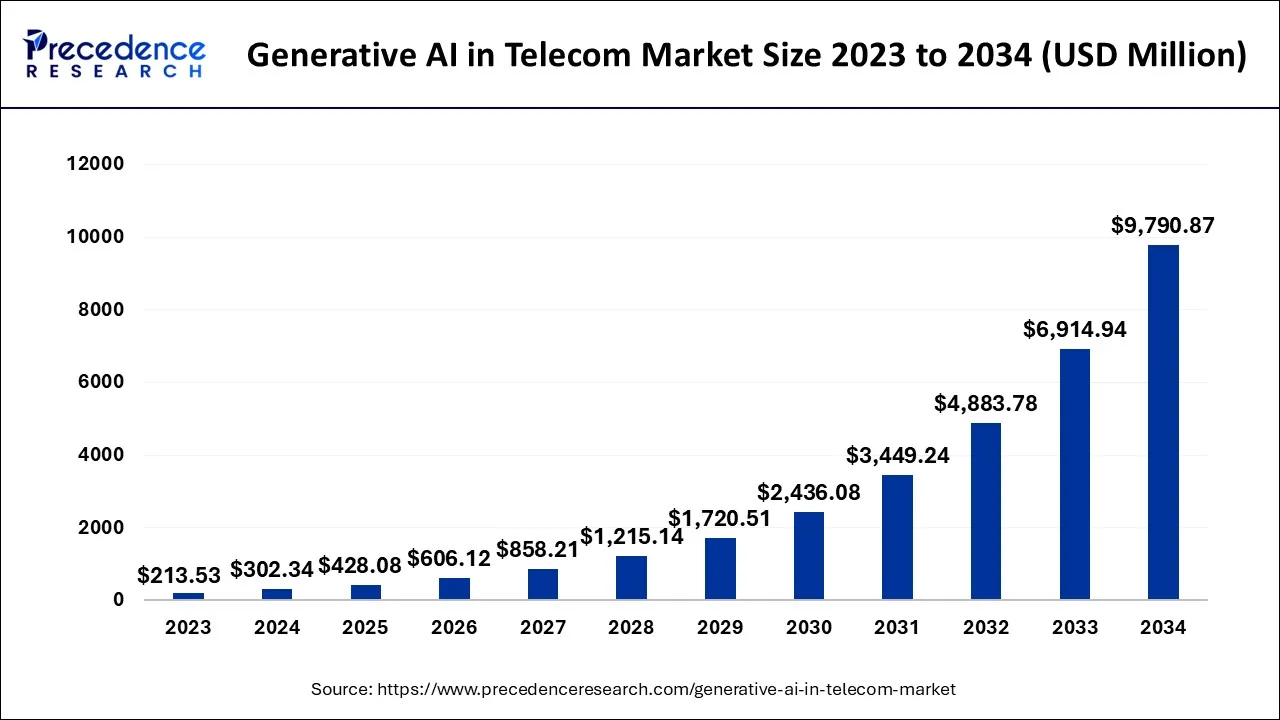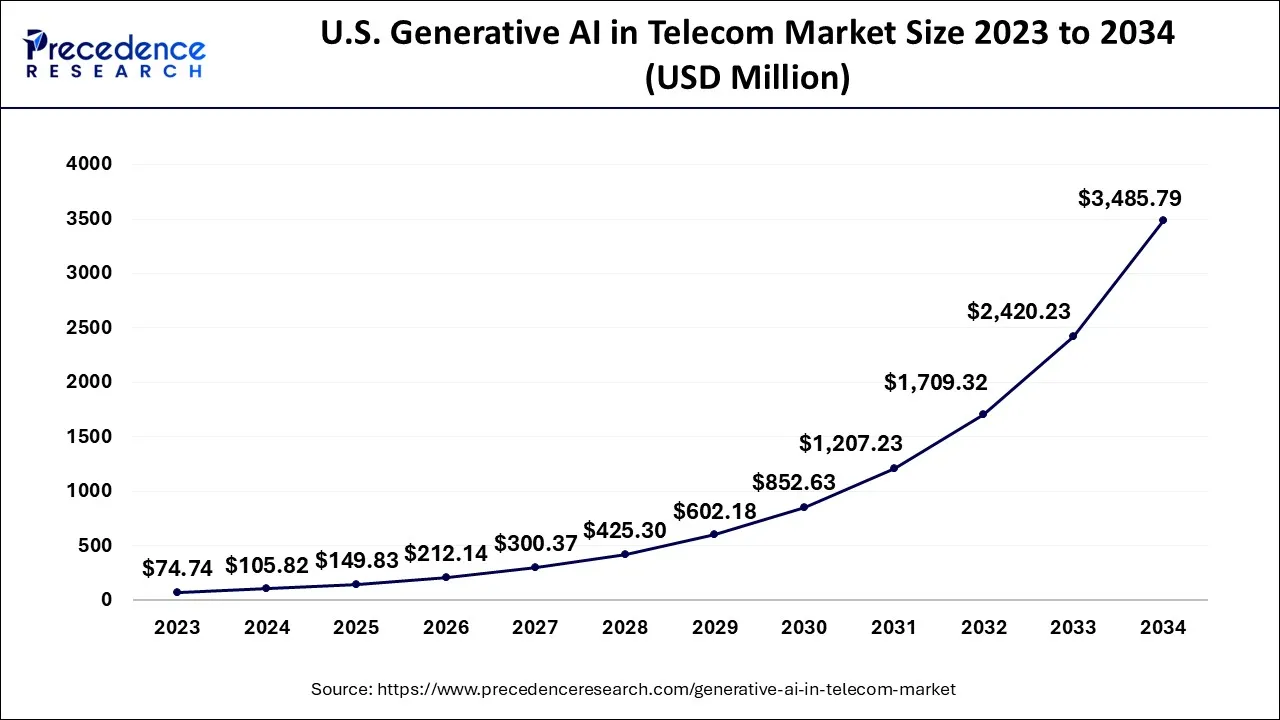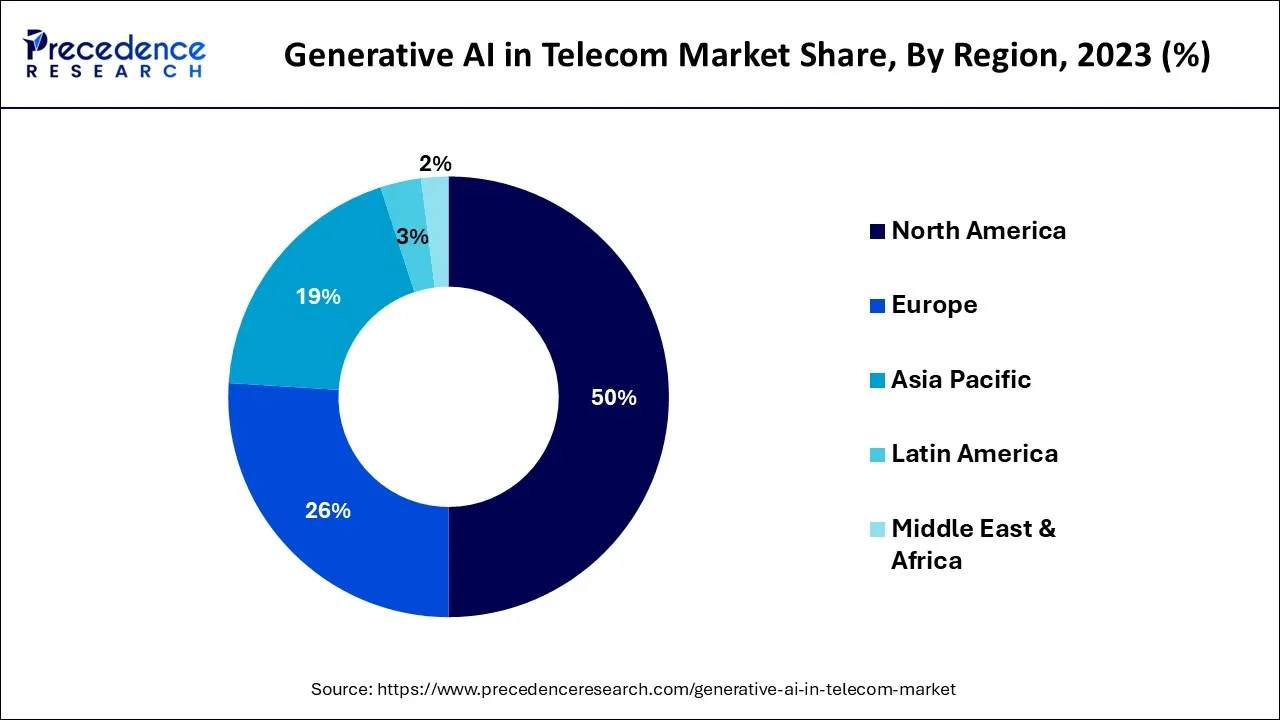January 2025
The global generative AI in telecom market size is calculated at USD 302.34 million in 2024, grew to USD 428.08 million in 2025, and is predicted to hit around USD 9,790.87 million by 2034, expanding at a CAGR of 41.59% between 2024 and 2034. The North America generative AI in telecom market size accounted for USD 151.17 million in 2024 and is anticipated to grow at the fastest CAGR of 41.73% during the forecast year.
The global generative AI in telecom market size is worth around USD 302.34 million in 2024 and is anticipated to reach around USD 9,790.87 million by 2034, growing at a CAGR of 41.59% over the forecast period from 2024 to 2034.

The U.S. generative AI in telecom market size is accounted for USD 105.82 million in 2024 and is projected to be worth around USD 3,485.79 million by 2034, poised to grow at a CAGR of 41.83% from 2024 to 2034.

North America is expected to dominate the market during the forecast period. The growth is attributed to the increasing adoption of generative AI-powered chatbots and virtual assistants to enhance customer service and support. These AI systems are deployed across various communication channels, such as websites, mobile apps, and social media platforms, to provide personalized and efficient customer interactions. Telecom operators in the region have leveraged generative AI to automate customer inquiries, reduce response times, and improve overall customer satisfaction. Moreover, the growing investment in the telecommunication industry such as expanding network infrastructures, Wi-FI, broadband and shifting to the 5G are other aspects that propel the market growth in the region.

Asia Pacific is expected to experience a considerable growth rate over the forecast period. The growth in the region is attributed to the growing smart city initiatives and the Internet of Things (IoT) deployment. Generative AI plays a crucial role in enabling smart city applications and IoT solutions in the telecom sector. By analyzing data from connected devices, generative AI models can optimize resource allocation, enhance energy efficiency, and improve urban services. This application of generative AI contributes to overall customer satisfaction by creating more sustainable and efficient cities. Therefore, this is expected to drive market growth over the projected period.
The telecommunications industry is not an exception to the enormous gains being made in generative AI, a type of artificial intelligence. To improve operations, enhance customer experiences, optimize network infrastructures, and spur innovation, telecom businesses are using generative AI approaches. Natural language processing and chatbots are two areas where generative AI has been found useful. Chatbots powered by generative AI can effectively manage the enormous amount of customer inquiries that telecom business frequently obtains. Chatbots can comprehend and produce correct and contextually appropriate replies by being trained on enormous databases of customer questions and responses.
This enables them to offer customers prompts help and support. Another significant application of generative AI in telecom is network optimization. Telecommunication networks generate massive amounts of data related to network performance, traffic patterns, and user behavior.
By leveraging generative AI models, telecom operators can analyze this data and generate insights to optimize their networks, predict network failures, and improve overall performance. For instance, generative AI can be used to stimulate network traffic and identify potential bottlenecks or predict demand fluctuations to allocate network resources effectively. Furthermore, this technology can contribute to innovation and the development of new services in the telecom sector. By training models on diverse datasets and generating new ideas, companies can explore novel offerings and identify untapped opportunities. For instance, generative AI can be used to create new product designs, generate personalized service recommendations, or stimulate user experiences before deploying new features. The market for generative AI in telecom is witnessing robust growth as telecom operators leverage the power of AI to enhance customer service, optimize networks, drive predictive analytics and foster innovation. With continued advancements in AI technology and the increasing availability of data, generative AI is poised to play a vital role in shaping the future of the telecom industry.
| Report Coverage | Details |
| Market Size in 2024 | USD 302.34 Million |
| Market Size by 2034 | USD 302.34 Million |
| Growth Rate from 2024 to 2034 | CAGR of 41.59% |
| Largest Market | North America |
| Base Year | 2023 |
| Forecast Period | 2024 to 2034 |
| Segments Covered | By Type, By Application, and By Deployment |
| Regions Covered | North America, Europe, Asia-Pacific, Latin America, and Middle East & Africa |
Emphasis on improving client services
AI in telecommunications can automate customer service more readily and provide customers with a more individualized experience. Managing clients and resolving each issue separately is challenging. A sizable staff is required round-the-clock to resolve customer complaints. The importance of automating customer service jobs has been especially highlighted by the recent outbreak. In this case, the advantages of AI are then utilized. According to a Deloitte Survey, for instance, executives from the telecom, tech, and media sectors acknowledged a sizeable investment in the development of cognitive technologies based on AI, with 40% citing significant benefits. Of these, 33% (or 24%) said they expected cognitive computing to have a substantial impact on how their organizations operate. Thus, the utilization of generative AI in improving client services in the telecommunication industry is expected to drive market growth over the forecast period.
Lack of skills and resources
Implementing generative AI in the telecom business necessitates particular knowledge, experience, and resources. Developing, training, and sustaining generative AI models necessitates a professional team with knowledge in machine learning, data science, and AI engineering. However, there is a scarcity of experts with these skills, resulting in a skill gap in the business. Furthermore, adopting and administering generative AI systems could require large processing resources and infrastructure investments, which may pose monetary limits for some telecom businesses. Therefore, the lack of skills and resources might be a major restraint for the market expansion during the forecast period.
Streamlined operations
Multiple industries focus on field service and operational efficiency for cost management and boosting customer satisfaction. Applying generative AI to field service devices, in particular, may speed up diagnostics and analysis, as well as assist with installation, parts, and troubleshooting, as well as reducing the number of times organizations must dispatch vehicles and improve field service training. Generative AI will also increase IT development productivity by allowing code creation and debugging to create reliable software goods and services. Thus, the streamlined operation offered by generative AI provides a potential opportunity for market growth over the projected period.
Based on the type, the global Generative AI in the Telecom market is segmented into text-based, image-based and voice-based. The text-based segment is expected to dominate the market during the forecast period. Text-based generative AI in telecom refers to the application of artificial intelligence techniques to generate text-based content or interact with users through text-based communication channels in the telecommunication industry. This involves training AI models on large datasets of text data, such as customer inquiries, responses, network logs, and other relevant information, to enable the generation of contextually relevant and meaningful text outputs. One of the primary applications of text-based generative AI in telecom is customer service and support.
Telecom companies often receive a high volume of consumer queries through various text-based channels, such as chat platforms, messaging apps or email. Text-based generative AI systems, such as chatbots or virtual assistants, can be trained to understand and respond to customer queries effectively, providing timely and accurate assistance. These AI-powered systems use natural language processing techniques to comprehend the intent and context of customer messages and generate appropriate responses. By leveraging text-based generative AI, telecom companies can improve customer service, handle inquiries at scale, and reduce the workload on human customer support agents. On the other hand, the image-based segment is expected to grow at the fastest CAGR over the projected period.
Telecommunication companies produce a large volume of image-based information, such as commercials, promotional materials, and multimedia content. Content analytics and optimization may be enabled by using generative AI to evaluate and produce insights from these images. To provide tailored suggestions and optimize content strategy, AI models may assess user responses, preferences, and engagement with image-based content. This segment focuses on using generative AI to improve image-based content and increase client engagement. Thus, this is expected to drive the segment growth over the forecast period.
Based on the application, the global Generative AI in the Telecom market is segmented into enhanced customer satisfaction, automated monitoring solutions, manage dynamic networks, improve network performance, network security and fraud mitigation, and network orchestration. The enhanced customer satisfaction is expected to capture the largest market share over the forecast period. Telecom companies can utilize generative AI to analyze customer data, including usage patterns, preferences, and demographics, to generate personalized service recommendations.
By understanding individual customer needs, generative AI models can suggest tailored telecom plans, additional services, or promotional offers. This segment focuses on using generative AI to provide customers with personalized and targeted recommendations, thereby increasing customer satisfaction. In addition, generative AI-powered chatbots and virtual assistants can be employed to offer proactive customer support. Thus, the increasing application of generative AI in telecom to resolve customer concerns is expected to drive market growth over the analysis period.
Based on the deployment, the global Generative AI in the Telecom industry is divided into on-premises, cloud-based, edge and hybrid. The cloud-based segment is expected to grow at the highest CAGR over the forecast period. Cloud-based solutions offer elasticity, allowing telecom operators to dynamically scale their generative AI infrastructure based on demand. During peak periods or when handling intensive AI workloads, cloud platforms can quickly allocate additional computational resources to ensure optimal performance. This scalability helps telecom companies optimize costs by paying only for the resources they need, avoiding overprovisioning of infrastructure. Therefore, these characteristics of cloud-based generative AI drive the market growth over the forecast period.
Segments Covered in the Report
By Type
By Application
By Deployment
By Geography
For inquiries regarding discounts, bulk purchases, or customization requests, please contact us at sales@precedenceresearch.com
No cookie-cutter, only authentic analysis – take the 1st step to become a Precedence Research client
January 2025
July 2024
September 2024
January 2025